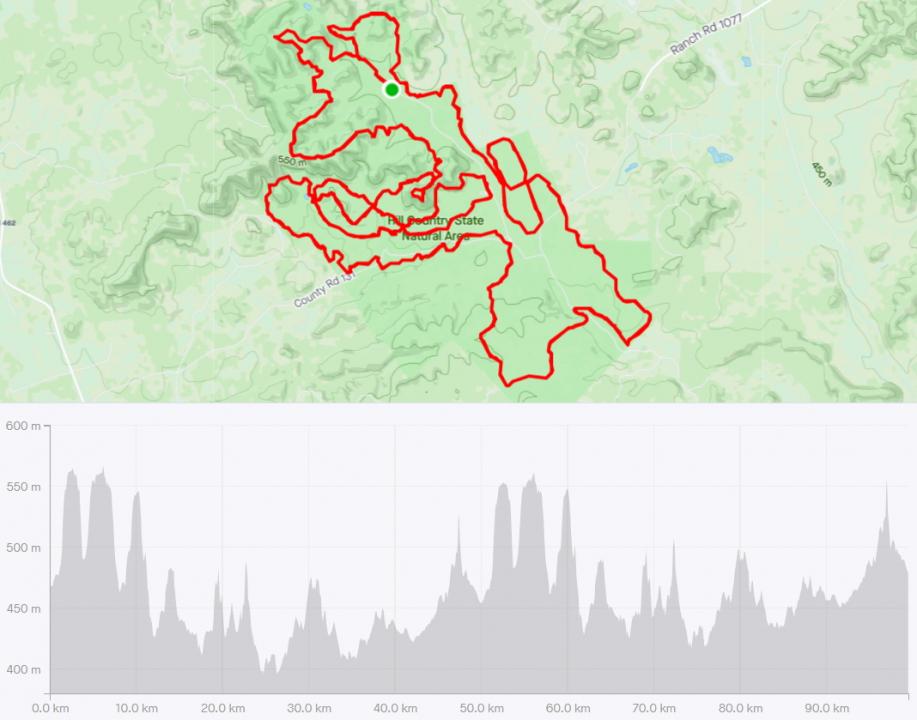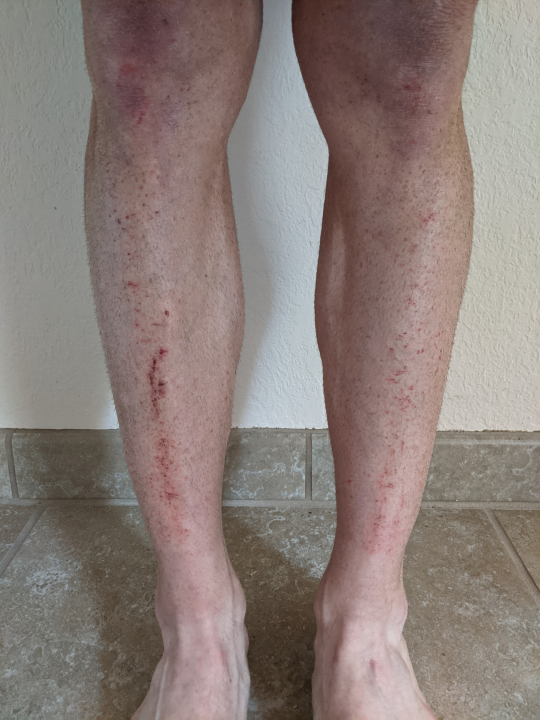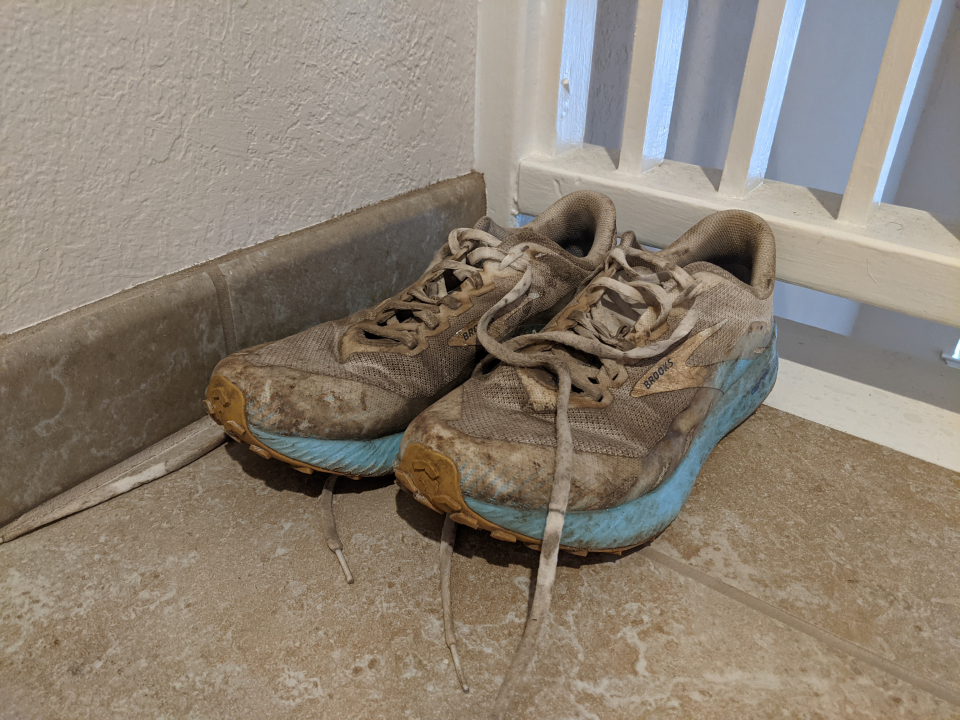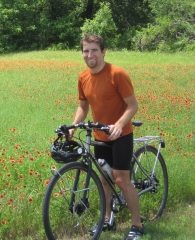Bandera 100k
The Bandera 100k was the first race I planned to do in the Texas Trail Championship, and had the potential to be the hardest. Plenty of climbs, technical terrain, and probably the most competitive field I’d see at any race this spring. I’d be lucky to place in the top 10.

Going into any race, I usually have multiple goals: an optimistic one, a more reasonable goal, and one “I won’t be disappointed in myself” goal, sometimes with a few more in between. Going into the Bandera 100k, my goals were (in order of increasing difficulty) beat 10 hours, beat my previous time (9:34), place in the top ten, and beat 9 hours.
I had thought most members of the Wimberley Valley Running team were planning to run the Bandera 100k, but by the time we were a week away from the race, only three still planned to do it. A big part of why I agreed to join (and do the race series at all) was the idea that this would be a fun thing to do as a team, and specifically, we’d carpool to the races.
Our de facto leader was one of the guys who withdrew from the race in the weeks leading up to it. I had to hear this from another team member, since he hadn’t bothered to tell the team, nor did he try to get a carpool going.
During the week prior to the race, I tried talking to one of the other guys in order to arrange a carpool and share a campsite (and have him borrow some of my camping gear). Long story short, in the last two days leading up to the race, Matt changed his plans for both his driving and lodging arrangements at least three times each. Sometimes the plans involved me, and sometimes they didn’t. In the end (the day before the race), the final plan was he’d carpool and split a hotel room with the other guy, and both of their wives were coming too. I drove out and camped on-site by myself.
Just as I was getting into Hill Country State Natural Area, where there’s no phone signal, Matt texted me one last time, asking for a ride back home from the race. I agreed. All that meant was I’d have to wait at the finish area for a few hours after I’d completed the race. No biggie; it’d give me time to collect my drop bags and pack up. That way, once he finished, we could simply leave.
As usual, I didn’t get great sleep the night before the race, but it wasn’t the worst night of sleep either. My morning routine was short, and I had time to take down the tent before the race started. It had rained off and on the night before, and there was still a little mist falling. It was cool, but not cold. It was very dark.
The race started at 6:30 AM, even though sunrise wouldn't be until after 7:30. As a result, you had to start out carrying a light of some kind. I don’t like carrying anything, nor running in the dark, and running on top of mud and slippery rocks didn’t make me like it any more. It was difficult figuring out how to pace; in some ways it felt like I was going too fast over the tricky rocks and without being able to see well, but it also felt like I could be running much faster. In a race of this length though, maybe it was better not to push myself from the get-go.
After 15 minutes or so, I was running behind two guys, one of which was Brian, a guy I’d previously talked with at another race. The other guy was from out-of-state and had never run this course before.
“Yeah, don’t worry about going fast for now,” Brian advised. “What people do is they come out to this race and they try pushing the pace, and they slip and hurt themselves early on. Just get through it for now. This race is all about the second lap.”
I stayed with them until we got to the first aid station, 8 km into the race. I wanted to ditch my arm warmers in my drop bag. The volunteers pointed me in one direction, even though my drop bag was literally in the opposite direction. In the 20-30 seconds it took to find my drop bag, Brian and the other guy were long gone.
I figured I’d probably catch up to them by the next aid station, especially once dawn started to break. It took longer than usual before the landscape lit up, as it was a cloudy day, still drizzling off and on. My pace was still significantly slower than I wanted, and by the time the next aid station was getting close, I was disappointed that I hadn’t caught those guys yet. I tried pushing the pace a little more, taking myself slightly out of my comfort zone, given the slick rocks. I’m notably timid on downhills, which is costly in terms of time.
*scuff* - WHAM! - “FUUUCK!!”
Yeah, so that’s why I’m timid on downhills. I suck at them.
I’d nicked my toe on a rock - not even very hard - and on this steep and slippery downhill, that was enough to make me faceplant onto the rocky trail. I'd managed to put my hands out to break my fall, so nothing hit the ground hard enough to cause injury, but it still hurt - a lot. My hands were both scuffed and bloody, and before I even got up, I could feel a wave of adrenaline rushing through me.
I laid in place for a minute before standing up, then stayed put for another minute before I started walking. The adrenaline rush was making me dizzy, and I didn’t want to fall over again. In the meantime, about 20 runners passed me. A few asked if I was OK. I eventually started walking with a purpose and managed a jog. The aid station was only a few minutes away; I should at least be able to get cleaned up.
Unfortunately, this is where the photographer was, so he only got photos of me walking and checking my wounds.
One of the volunteers found some Band-Aids and tried putting them on, but since it was still raining half the time, everything was wet - including my hands - and they wouldn’t stick. By now, the blood was covering most of my palm and running down onto my fingers. With nothing better to do about the problem, a volunteer wiped my hands off with a wet wipe - at least that would clean the wound - and I ran off with my hands still bleeding.
Combining the time I was stopped, walking, and getting cleaned up, the fall probably cost 7-8 minutes. A lot more than the time I was trying to shave off by running through the downhill. I should’ve taken Brian’s advice.
The section between the 2nd and 3rd aid station is the longest between any two aid stations and also the most hilly and technical part of the course. It’s also the part where you famously have to run through sotol cacti like they’re a saloon door. By the time I reached the 3rd aid station, my hands were bleeding less, but my shins had joined the party.

My average pace, which dipped to an abysmal number after my fall, barely improved. It became obvious that I wouldn’t reach my most optimistic goal. I started setting new ones and ran the math in my head so see what I’d need to do from here on out.
After the 3rd aid station, which comes slightly past the halfway point of each loop, the course gets considerably easier. There were still rocks here and there, but it was no longer the case that the whole trail was an ongoing pile of rocks. My speed picked up in a big way and I started passing some of the runners that had passed me after I fell. My average pace kept dropping. I continued crunching the numbers in my head to see what I’d have to do in order to meet some of my goals. It looked more and more likely that I’d pull them off. The trail improved until you could keep your head up while running, though the mud stuck to your shoes and made them heavy. I kept speeding up.
By the time I completed the first loop, I was slightly ahead of pace to finish in 9:30. That became my new goal. I’d simply have to finish the second loop in roughly the same amount of time. Normally, even splits are difficult in a race of this distance, but not having to run in the dark and not hurting myself could potentially make up for the inevitable fatigue. It had stopped raining, but the ground was still mostly wet. I felt great. My hands had stopped bleeding.
The first 10 km of the course felt much easier than the last time around, in no small part because I didn’t have to do them in the dark this time. The trail itself seemed a lot less rocky now that I could see it plainly. I ran much faster than I had on the first loop. The ground was maybe a little drier. I didn’t slip and fall this time.
Nearing the second aid station, I saw the photographer again. This time, I was running at a solid pace - 65 km into a run - with a wide grin on my face.
He recognized me and smiled back as he took photos. “Dude! Back from the dead!”
My smile got even bigger. The photos he took turned out better this time.
It figured I’d slip well behind target pace during the technical first half of the loop, but didn’t lose nearly as much time as expected. By the time I made it to the Nachos aid station, just past the halfway point, I barely needed to speed up in order to finish in 9:30. Normally, the prospect of picking up the pace 76 km into a race would sound impossible, but considering the much easier trail conditions in the second half of the loop, it seemed almost a certainty. I still felt good.
I was mostly holding serve for the first few km past Nachos, where the trail is a slow, gradual uphill with a fair amount of rocks. Once through there, with 15 km to go, I found myself on the fastest part of the course: entirely flat, on hardpack dirt, not muddy this time. I was consistently running each km in less than 5:00 (each mile in under 8:00). I only needed a 5:40/km pace to reach my goal, and I was giving myself almost a full minute of buffer with every km.
By the time I reached the last aid station, finishing in under 9:20 was looking like a possibility. I knew there was one last hill - a gnarly one that forced you to walk both up and down - but most of the final 7 km to the finish would be nearly as flat and fast as the previous 8 km. I still felt good.
By now, I was passing several people who were hiking the 50k, nearly done with their one and only loop. Universally, they cheered me on. My spirits were still high until I got to that one last hill. Sonofabitch, doesn’t this hill know I’m trying to finish in 9:20?
Once past the hill, it was an easy jog downhill to the finish. I managed to run the last 2 km in under 5:00 each. If I could still hold a 5:00 km at the end of a 100k course like that…I liked the sound of holding the same pace on a much flatter course in four weeks’ time. For now, another belt buckle in the books.
It wasn’t until after I stopped running that everything started hurting. It bordered on agonizing to walk half a km up a hill to retrieve a drop bag, then back down, then another 0.5 km to the parking/camping area. I was glad I’d already taken down the tent before the race.
Matt wouldn’t finish for another few hours, so I drove around the park to pick up my drop bags at Equestrian and Chapas aid stations. While there, I went ahead and had a grilled cheese sandwich at Equestrian and a bacon-cheese quesadilla at Chapas. By the time I got back to the finish area to wait for Matt, I was feeling a lot better. And colder.
When I picked up my drop bag at Equestrian, a volunteer recognized me and also knew who Matt was.
“Has he come through on his second loop?” I asked.
“Yeah, second loop.”
“Do you know how long ago? Ballpark?”
“Ehhhh, I’d say…hour and a half ago.”
That meant Matt would be finishing at about 8:30, maybe 9:00 if he slowed down. It was 5:00 now. It’d be a while.
Now that I’d cooled off, I piled on some warm clothes, did some stretching, and grabbed a book and a canvas chair. Plopped down in the finish area, picking a well-lit spot so Matt would have an easy time finding me. Never read much of my book, because I spent most of the time talking to other finishers, most of which were simply hanging around before making the drive home. A few were, like me, waiting on a buddy. I told all the volunteers I was waiting on a guy named Matt, so if they see a guy with a mustache, tell him Rob is here.
Starting at about 8:00, I started paying closer attention as runners crossed the finish line. I didn’t get out of my chair for each one, but at least turned my head to see if it was Matt. Didn’t see him. I occasionally got up to drink more water or get another snack from the aid station. It had been hours since I’d finished and I still hadn’t had a meal or a shower.
9:00 rolled around. I'd finished five hours prior and spent most of that time waiting at the finish area for Matt. “By now, that friend of mine owes me a dinner,” I said to another finisher. He laughed.
10:00 rolled around. That dinner he owes me is getting more expensive. I asked a few volunteers if they could confirm whether or not Matt had finished and I’d simply missed him. Since there was no internet connection out there, they couldn’t help in that regard. They could tell I was worried about him, so they radioed the other aid stations on walkie-talkies and asked if anyone had been hurt on the trail. No such reports. I guess he just ran out of gas.
11:00 rolled around. How long before I give up and go home? I can’t leave someone stranded here, with no ride and no way to call anyone. If I have to, I’ll sleep in my car and tell the volunteers to tell Matt where I’m parked.
Once again, I got up to grab another snack. A guy sitting near the aid station recognized me, then asked, “Have you seen Matt?”
“No. Why? Have you heard anything about him?”
“He’s right over there!” He pointed back toward the finish area. “He was talking to some guy with a beard.”
No friggin’ way…
I walked over and found the bearded man in question. Sure enough, Matt finished just over an hour ago, didn’t see me right away (I was probably grabbing a snack again or taking a leak), so he stayed in one place, talked to one guy, then got a ride into town after about an hour. We were probably about 15 meters from each other for about an hour, him behind a display of bottled water, me in a chair in the most well-lit spot possible.
“So yeah, he said he was looking for a guy named Rob, then we just hung out and talked for an hour, until he found a guy that could give him a ride into Bandera. He’s probably getting a hotel. He only left 5-10 minutes ago; you could probably call him when you get in town and stay at the hotel with him.”
“No, I’m going home. I’m so freaking pissed off. I’m going home.”
“Hey, don’t be pissed at me…”
“I’m not. Thanks for your help.”
I could’ve been home, showered, and eating a hot meal by 6:00, before it even got dark. Instead, I had to drive two hours in the dark, on roads with no lights and no reflectors on the roadway. I hardly drive and don't even like doing it in the daytime. It had gotten foggy again, so high beams didn’t work. I was exhausted, but my anger, as well as fear for my safety, kept me awake and alert.
I finally made it home and took a long-overdue shower. I still needed an outlet for my frustration, so I texted a friend about it, simply to vent, before going to bed. I also sent a text to the four guys who’ve bothered to join a group chat, telling them we need to plan and communicate better when it comes to races. I’d been awake for 21 hours at that point, so the tone wasn’t the friendliest.
In the end, I managed a finish time of 9:19, 15 minutes better than last time, despite the slippery, muddy conditions and the hard fall. The winner finished in 8:10, over an hour ahead of me. I managed 14th place, missing out on the top 10 by a significant margin. Notably, everyone ahead of me was from out-of-state and probably was sponsored. The next-best Texan was over an hour behind me.

Which leads to some good news: By my own calculations, I earned 89 points in the Texas Trail Championship, out of a possible 100 at this race. Assuming no one from out-of-state participates in the series, that would put me in the lead, with the next-closest score at least 10 points behind.
Next up: The Rocky Raccoon 100-miler, in four weeks’ time. The only 100-miler and easily the longest race I plan to do this spring, more than 1.5 times the length of the Bandera 100k. That said, it’s on a much flatter and less technical course than Bandera; many people do the Rocky Raccoon as an introduction to 100-milers, since the course is considerably easier than most, and veterans come out to try to set a personal best. It’s entirely possible that the most difficult race of the series is already behind.



 June
June

